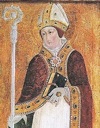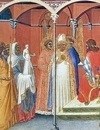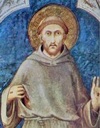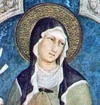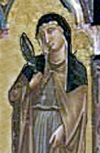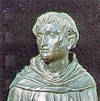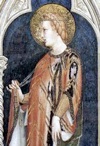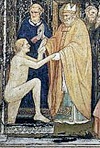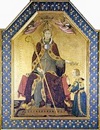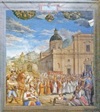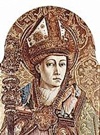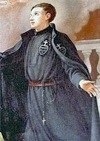Early Christian Period
St Felician of Foligno seems to have evangelised Assisi in the early 3rd century. According to tradition, the Roman governor of Assisi expelled him after he had preached in the forum, and he then took up residence in a hut next to the Roman mausoleum on the footpath between Porta Nuova and San Damiano. (A small chapel next to the mausoleum replaces an ancient church that was dedicated to him). He continued to attract converts and such was his success that he was beaten and forced to return to Foligno.
Less reliable but extremely durable traditions relate to the early bishops of Assisi:
-
✴St Rufinus, who is venerated in Assisi together with his son, St Cesidius
-
✴St Victorinus, his successor; and
-
✴St Sabinus (shared with many Italian cities, including Spoleto).
13th Century
St Francis is, of course, the most famous of the saints of Assisi. The city has for centuries attracted pilgrims wishing to venerate his relics in the Basilica of San Francesco and to visit other sites with which he is associated.
The other 13th century saints from Assisi are:
-
✴St Clare (St Francis' first female follower);
-
✴St Agnes of Assisi (St Clare's sister); and
-
✴the somewhat shadowy St Rufinus d' Arce.
The following saints were among those that had altars or chapels at San Francesco:
-
✴St Antony of Padua, a Franciscan and contemporary of St Francis (died 1231, canonised in Spoleto in 1232);
-
✴St Elizabeth of Hungary, a member of the Hungarian royal family and relation by marriage of the Emperor
Frederick II (died 1228, canonised in Perugia in 1235);
-
✴St Stanislaus (died 1079, canonised in San Francesco in 1253); and
-
✴St Louis of Toulouse, a Franciscan and member of the Angevin dynasty of Naples (died 1297, canonised 1317).
Sacro Velo della Madonna
Tommaso Orsini, Count of Manoppello sold this relic of the sacred veil of the Virgin to the friars of San Francesco in 1414. It was subsequently displayed for veneration each year on the Feast of the Annunciation. From ca. 1595, it was taken in procession on this day to Santa Maria degli Angeli (as depicted here). It is now kept in the Cappella di San Giovanni Battista in the lower church.
Later Saints
Two interesting saints were among those that had chapels in San Rufino:
-
✴St Vitalis of Assisi, a 14th century hermit to whom a confraternity in Assisi was dedicated; and
-
✴St Emidius, patron saint of Ascoli Piceno, whose cult was revived in 1703 when Ascoli Piceno survived an earthquake that devastated much of the region. The cult spread to Assisi and other Umbrian cities that survived the earthquake there in 1751.
St Gabriel (Francis Possenti), who was born in Assisi in 1838 and christened in San Rufino, moved to Spoleto in 1841 and is venerated there.





